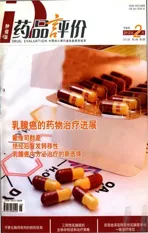三阴性乳腺癌的生物学特征和治疗策略
2012-12-08上海交通大学医学院附属瑞金医院乳腺疾病诊治中心朱丽唐益清
上海交通大学医学院附属瑞金医院乳腺疾病诊治中心 朱丽,唐益清
三阴性乳腺癌(triple negative breast cancer,TNBC)是指雌激素受体(ER)、孕激素受体(PR)和人表皮生长因子受体2(Her-2)均为阴性的乳腺癌。这类乳腺癌占乳腺癌病理类型的10%~23.8%[1-5],具有特殊的生物学行为和临床病理特征,预后较其他类型的乳腺癌差,是近年研究的热点之一。
2000年美国斯坦福大学Perou等[6]通过cDNA微阵列技术分析42例乳腺癌患者的65例手术切除标本的基因表达特征,将乳腺癌分为5个亚型:导管A型(Luminal A)、导管B型(Luminal B)、Her-2过表达型、基底细胞样型(basal-like phenotype,BP)和正常乳腺样型。BP乳腺癌分型的金标准是微阵列基因谱分析,而该项技术目前难以在临床检测中开展,寻求BP乳腺癌理想的免疫组化标志物是切实可行的方法之一。迄今为止,Nielsen等[7]定义的BP乳腺癌免疫组化标志物最为适宜,即ER、PR和Her-2阴性,细胞角蛋白(cytokeratin,CK)5/6和表皮生长因子受体(epidermal growth factor receptor,EGFR)阳性。同时Nielsen等[7]还将三阴性(triple negative,TN)即ER、PR和Her-2阴性作为BP乳腺癌的主要特征。文献报道约50%~60%的TN乳腺癌是BP型。故临床工作中利用免疫组化检测ER、PR和Her-2这3种标志物,将乳腺癌分为Luminal A型、Luminal B型、Her-2过表达型和TN型[8-10]。但实际上越来越多的研究表明TNBC并非完全等同于BP乳腺癌,两者之间存在交错重叠[11-13]。
TNBC成为近年的研究热点之一,一方面是因为该类患者尚无特异性治疗,另一方面是该类患者预后最差。TNBC占全部乳腺癌的10%~17%,常见于较为年轻的(<50岁)绝经前非洲、非洲裔美国、西班牙和乳腺癌易感基因-1(breast cancer susceptibility gene-1,BRCA1)基因突变携带者妇女。韩国报道的TNBC比例为14.7%,日本为15%,复旦大学附属肿瘤医院报道的我国最大规模的随访资料显示TNBC比例为18.62%,与西方国家的比例近似。TNBC以侵袭性的临床表现为特征,与其他类型相比,有着最差的总生存率和无进展生存期,腋窝淋巴结转移率高,肺转移的发生较早[14],与乳腺癌常见的骨转移相比,TNBC内脏转移率高[15],局部复发率高[16],治疗后的1~3年内为TNBC的复发高峰期,多数患者在5年内死亡[17]。与其他类型的乳腺癌相比,TNBC肿瘤直径大、增殖活性高、常有BRCA1和p53基因突变、常表达EGFR,TNBC最常见的组织病理学类型是浸润性导管癌和化生性癌[7,16,18-21],多为低分化,有着较高的组织学分级和有丝分裂计数。在影像学检查方面,一项29例TNBC患者的MRI初步研究表明,28例(97%)为肿块型病变,表现为典型的恶性增强动力学特征。还有一项研究使用定量18-氟脱氧葡萄糖(18fluorodeoxyglucose,18FDG)正电子发射体层显像技术检查TN乳腺癌,发现其对FDG的摄取加强,有着非常高的灵敏度(100%)。
TNBC尚无针对性的治疗指南,系统性化疗是目前主要的全身性治疗手段。临床研究发现TNBC对新辅助化疗较为敏感。Torrisi等[22]给予患者CEF方案(表柔比星25 mg/m2,第1、2天;顺铂60 mg/m2,第1天;5-FU 200 mg/m2,第1~21天)4个疗程,然后再给予3个疗程紫杉醇(90 mg/m2,第1、8、15天,每28 d为1个疗程),86%的患者经影像学检查证实为临床缓解,病理完全缓解(pathological complete response,pCR)率为40%,2年无病生存率(disease free survival,DFS)为87.5%。在辅助化疗方面,回顾性分析经蒽环类治疗TNBC的资料表明,手术后继以蒽环类为主的化疗方案,并不能改善患者的预后[23]。这可能与p53基因突变相关[24],故不推荐p53基因突变的TNBC患者使用蒽环类化疗方案。Sirohi等[25]的研究发现含铂类药物的化疗方案可以提高TNBC患者的有效率,Uhm等[26]的回顾性分析并未发现TNBC患者较非TNBC患者对含铂类药物化疗方案有更高的病理缓解率。两项回顾性研究发现,大剂量化疗(含环磷酰胺和塞替派)能使TNBC患者从中获益[27,28]。
TNBC因为ER、PR、Her-2均为阴性,无法针对这3个靶点实施靶向治疗,但研究发现TNBC常表达EGFR ,这便提示EGFR可能成为TNBC靶向治疗的一个重要靶点。EGFR的单克隆抗体西妥昔单抗和EGFR的络氨酸酶抑制剂吉非替尼和埃罗替尼都是针对EGFR这一靶点的药物。研究发现西妥昔单抗联合卡铂治疗晚期TNBC疗效优于西妥昔单抗治疗疾病进展后加用卡铂者[29],其有效率为18%[29]。此外,在预后判断指标的研究上,发现了多种有意义的分子标志物,如雄激素受体、丝裂原活化蛋白激酶(mitogen- activated protein kinase, MAPK)、ADP-核糖聚合酶1(polyADP- ribose- polymerase-1, PARP1)、CK19、蛋白激酶B(Akt)通路明显活化等,这都有助于我们寻找潜在的治疗靶点和特异性的治疗药物,如EGFR/Her-2抑制剂拉帕替尼、HSP90抑制剂、Ras抑制剂、src和abl激酶抑制剂达沙替尼等。
TNBC具有特殊的生物学特性及临床病理特征,其CK5/6、EGFR等表达多为阳性,具有高增殖性、分化差等特点,与BP乳腺癌和BRCA1相关性乳腺癌有较多相似之处。TNBC通过新辅助化疗可以达到较高的pCR,但是预后与其他亚型的乳腺癌相比仍较差。由于TNBC常高表达EGFR,其他信号传导通路亦有异常,目前已开展了针对这些靶点的研究,TNBC有望取得更好的预后。
[1] Rakha EA, El Sayed ME, Green AR, et al. Prognostic markers in triple negative breast cancer [J]. Cancer, 2007,109 (1): 25- 32.
[2] Siziopikou KP, Cobleigh MT. The basal subtype of breast carcinoma may represent the group of breast tumors that could benefit from EGFR- targeted therapies [J]. Breast, 2007, 16 (1): 104- 107.
[3] Cleator S, Heller W, Coombes RC. Triple negative breast cancer:therapeutic options [J]. Lancet Oncol, 2007, 8 (3): 235- 244.
[4] Bauer KR, Brown M, Cress RD, et al. Descriptive analysis of estrogen receptor (ER)- negative, progesterone receptor (PR)-negative, and Her-2- negative invasive breast cancer, the so- called triple- negative phenotype: a population- based study from the California Cancer Registry [J]. Cancer, 2007, 109 (9): 1721- 1728.
[5] 袁中玉,王树森,高岩,等.305例三阴性乳腺癌患者的临床特征及预后因素分析[J].癌症,2008,27(6):561- 565.
[6] Perou CM, Sorlie T, Eisen MB, et al. Molecular portraits of human breast tumours [J]. Nature, 2000, 406 (6797): 747- 752.
[7] Nielsen TO, Hsu FD, Jensen K, et al. Immunohistochemical and clinical characterization of the basal- like subtype of invasive breast carcinoma [J]. Clin Cancer Res, 2004, 10 (16): 5367- 5374.
[8] Sorlie T. Molecular portraits of breast cancer: tumor subtypes as distinct disease entities [J]. Eur J Cancer, 2004, 40 (18): 2667- 2675.
[9] Brenton JD, Carey LA, Ahmed AA, et al. Molecular classification and molecular forecasting of breast cancer: ready for clinical application[J]. J Clin Oncol, 2005, 23 (29): 7350- 7360.
[10] Sotiriou C, Neo SY, McShane LM, et al. Breast cancer classification and prognosis based on gene expression profiles from a populationbased study [J]. Proc Natl Acad Sci USA, 2003, 100 (18): 10393-10398.
[11] Rakha EA, Reis Filho J, Ellis IO. Basal- like breast cancer: a critical review [J]. J Clin Oncol, 2007, 25 (30): 4772- 4778.
[12] Bidard FC, Conforti R, Boulet T, et al. Does triple- negative phenotype accurately identify basal- like tumour? An immunohistochemical analysis based on 143 triple- negative breast cancers [J]. Ann Oncol, 2007, 18 (7): 1285- 1286.
[13] Reis- Filho JS, Tutt AN. Triple negative breast cancer: a critical review [J]. Histopathology, 2008, 52 (1): 108- 118.
[14] Rakha EA, EI- Sayed ME, Green AR, et al. Prognostic marker in triple negative breast cancer [J]. Cancer, 2006, 109 (1): 25- 32.
[15] Rodriguez- Pinilla SM, Sarrio D, Honrado E, et al. Prognostic significance of basal- like phenotype and fascin expression in nodenegative invasive breast carcinomas [J]. Clin Cancer Res, 2006, 12(5): 1533- 1539.
[16] Carey LA, Perou CM, Livasy CA, et al. Race, breast cancer ,subtypes,and survival in the Carolina Breast Cancer Study [J]. JAMA, 2006,295 (21):24922- 24502.
[17] Tischkowitz M, Brunet JS, Begin LR, et al. Use of immunohistochemical markers can refine prognosis in triple negative breast cancer [J]. BMC Cancer, 2007, 7: R134.
[18] Sorlie T, Perou CM, Tibshirani R, et al. Gene expression of breast carcinomas distinguish tumor subclasses with clinical implications [J].Pro Natl Acad Sci USA, 2001, 98 (69): 10869- 10874.
[19] Livasy CA, Karaca G, Nanda R, et al. Phenotypic evaluation of the basal- like subtype of invasive breast carcinoma [J]. Mod Pathol,2006, 19 (2): 264- 271.
[20] Yuli C, Shao N, Rao R, et al. BRCA1a has antitumor activity in TN breast, ovarian and prostate cancers [J]. Oncogene, 2007, 26 (41):6031- 6037.
[21] Korsching E, Pacheisen J, Agelopoulos K, et al. Cytogenetic alterations and cytokeratin expression patterns in breast cancer:integrating a new model of breast differentiation into cytogenetic pathways of breast carcinogenesis [J]. Lab Invest, 2002, 82 (11):1525- 1533.
[22] Torrisi R, Balduzzi A, Ghisini R, et al. Tailored preoperative treatment of locally advanced triple negative (hormone receptor negative and Her-2 negative) breast cancer with epirubicin, cisplatin,and infusional fluorouracil followed by weekly paclitaxel [J]. Cancer Chemother Pharmacol, 2008, 62 (4): 667- 672.
[23] Tan DS, Marchio C, Jones RL, et al. Triple negative breast cancer:molecular profiling and prognostic impact in adjuvant anthracyclinetreated patients [J]. Breast Cancer Res Treat, 2008, 111 (1): 27- 44.
[24] Geisler S, Lonning PE, Aas T, et al. Influence of TP53 gene alterations and c-erbB-2 expression on the response to treatment with doxorubicin in locally advanced breast cancer [J]. Cancer Res, 2001,61 (6): 2505- 2512.
[25] Sirohi B, Arnedos M, Popat S, et al. Platinum- based chemotherapy in triple- negative breast cancer [J]. Ann Oncol, 2008, 19 (11): 1847-1852.
[26] Uhm JE, Park YH, Yi SY, et al. Treatment outcomes and clinicopathologic characteristics of triple- negative breast cancer patients who received platinum- containing chemotherapy [J]. Int J Cancer, 2009, 124 (6): 1457- 1462.
[27] Rodenhuis S, Bontenbal M, van Hoesel QGCM, et al. Efficacy of high- dose alkylating chemotherapy in Her-2/neu- negative breast cancer [J]. Ann Oncol, 2006, 17 (14): 588- 596.
[28] Gluz O, Nitz UA, Harbeck N, et al. Triple- negative high- risk breast cancer derives particular benefit from dose intensification of adjuvant chemotherapy: results of WSGAM- 01 trial [J]. Ann Oncol, 2008, 19(5): 861- 870.
[29] Kilburn LS. 'Triple negative' breast cancer: a new area for phase Ⅲbreast cancer clinical trials [J]. Clin Oncol, 2008, 20 (1):35- 39.
